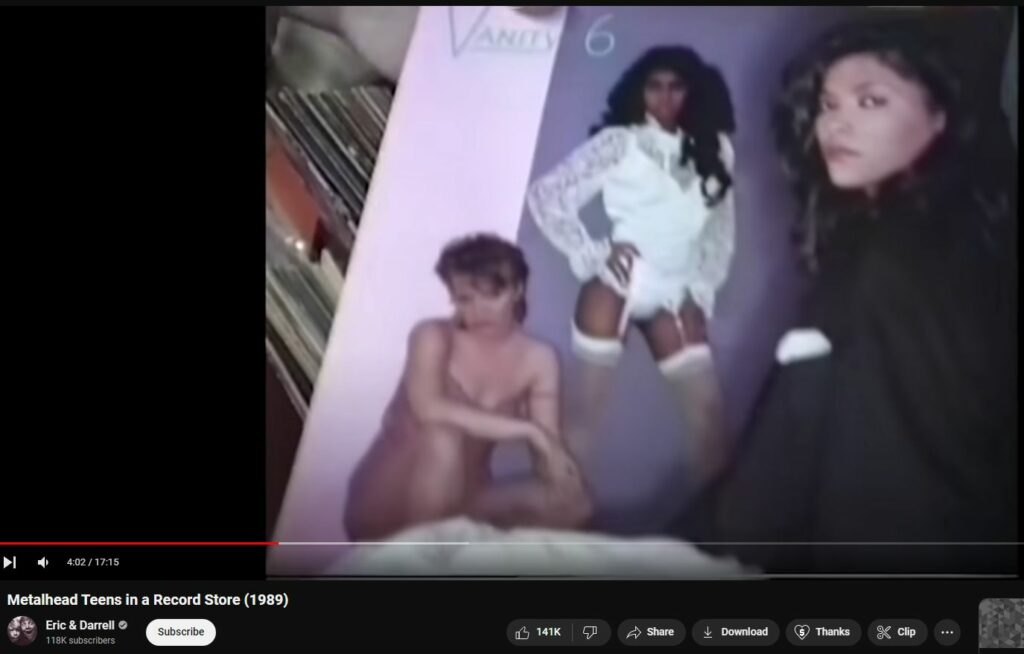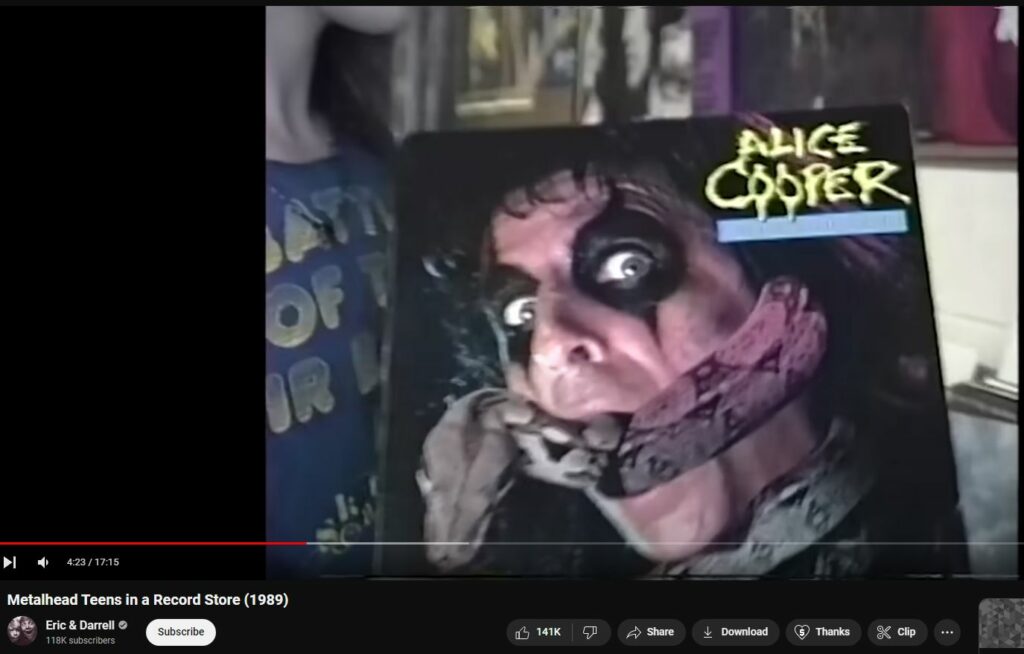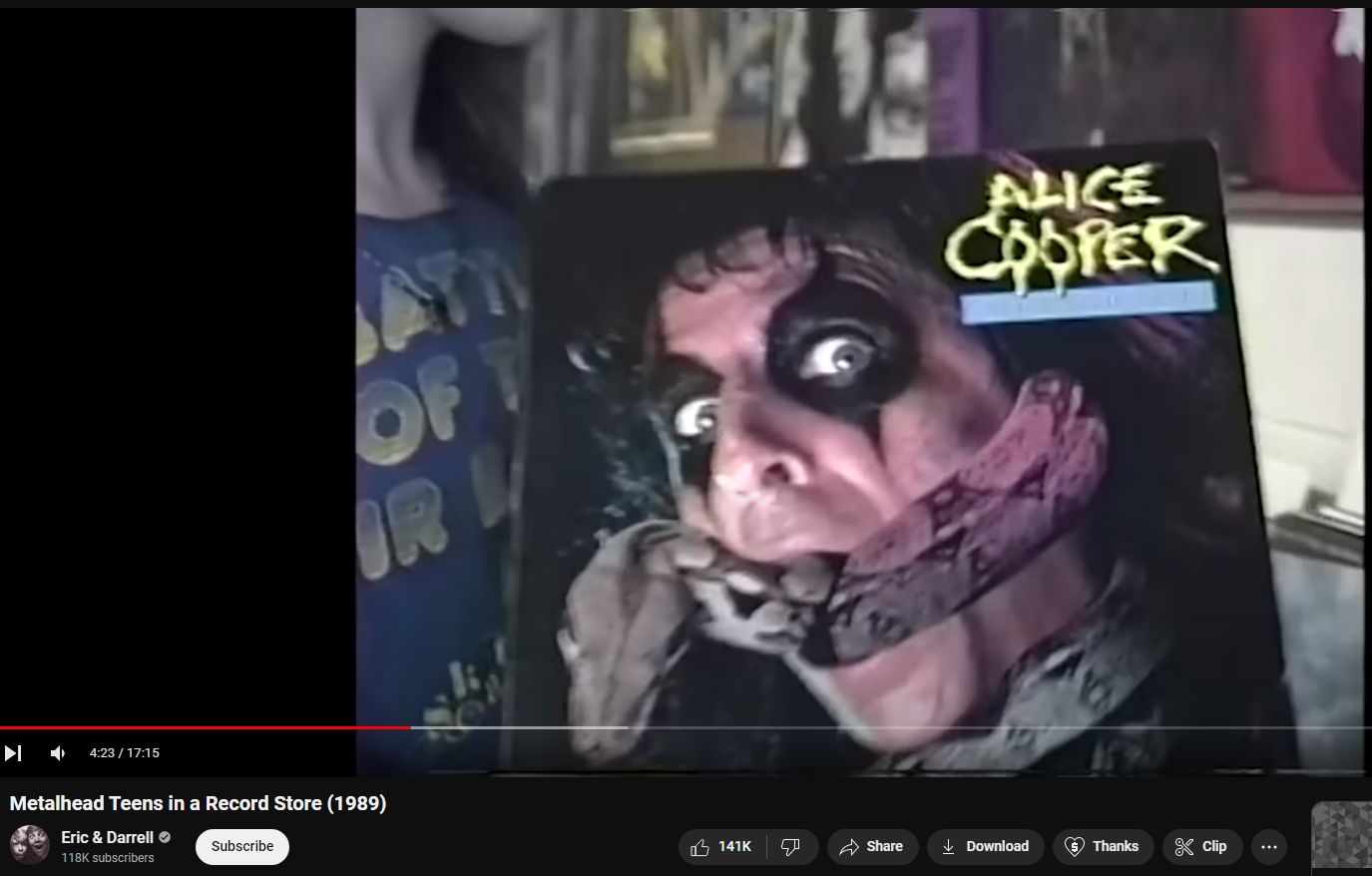Metalhead Teens in Record Store 1989
Flashbacks and Feedback Reveal our Haplessness as Social Creatures
“Mackabree. Whether you like it or you don’t like it, sit down and learn to love it…”
“I was born in 2004, so I want to thank you for messing around thirty years ago and recording this video, allowing me to vicariously witness what it was like to be a metalhead in the decade of the genre’s dominance.”
“This is crazy as hell. I live on this Road just 5 miles down the road from where he’s at. THAT KOREAN HOUSE RESTAURANT IS STILL OPEN TO THIS DAY! I was about the same age as these Kids I was 12 years old in 1989. I didn’t move to Huntsville until 2009 though. Awesome video! Thanks for sharing it.”
“It’s like stepping into a time machine and hanging out with the town legend.”
https://www.youtube.com/watch?v=IvHaL2BxqvM
80s child here and let me tell you that this was the best decade for being a child and teenager. This was every town in America back then when the internet/social media did not exist. This was my life at one point with a teenage brother sporting an Appetite for Destruction, Iron Maiden, Van Halen or Metallica T-shirt. He had the BMX bike and I had the ET Big Wheel. The summertime was never ending, the sun shined a lot brighter and 5 cent Now & Laters took out a few teeth.
I’ll never forget the day when I walked into the house to find the tv on…a countdown began, a moon-man appeared and this channel called MTV was introduced right before my eyes. I was in awe. I’ll never forget that moment. MTV, the HBO intro (look it up), Fraggle Rocks, Apple IIe, the 85/86 Chicago Bears, jelly shoes/bracelets, Garbage Pail Kids, Banana seat bikes, BMX bikes, big wheels, Hulk Hogan, Randy Savage, Sat morning cartoons, cereal with prizes inside…I’d take all that over any iPhone/Internet/Social media that plagues the world now. 80s generation, the last generation to know life before/after the Internet and all else to come with it. Perhaps, this is why us 80’s kids loved that time so much. Perhaps this is why later gens are watching this with admiration of a world they will never know.
Keep life real people. Live it 80’s style. Take a walk, talk to the locals, buy from a locally owned store, buy a record, get a mullet, ride a bike and appreciate the small things. 2024 now and wow…
“the sun is the same in a relative way but your older, shorter of breath…one day closer to death” Pink Floyd

Musical Mind Control: Unveiling the Subconscious Influences of Music and Art
In a world where music is omnipresent, it’s essential to delve into the less obvious aspects of its impact on society. Dr. Leonard Horowitz’s paper on “Musical Mind Control” provides a compelling lens through which we can explore how music and art serve as tools for social programming. This exploration extends into the realm of 33rpm album covers, which have historically influenced cultural norms and personal identities. By examining the constructs of thinking shaped by musical paradigms and the accompanying fashion vogues, we can better understand the roles dictated by society and the limitations imposed by personal identification with musical genres.
The Influence of Music and Art on Social Programming
Dr. Leonard Horowitz, a notable figure in the field of health and conspiracy research, has posited that music, particularly at certain frequencies, has a profound impact on human consciousness. His work on “Musical Mind Control” suggests that specific frequencies and harmonic structures can influence mood, behavior, and even societal trends. The concept isn’t new; throughout history, music and art have been used to inspire, control, and direct the masses. From the anthems that fuel national pride to the pop songs that define generations, the sonic landscape is a powerful medium of influence.
Horowitz’s theories align with broader discussions about the role of media in shaping public perception and behavior. Music, as a form of media, is particularly potent because it operates on both conscious and subconscious levels. The rhythms, melodies, and harmonies can evoke emotions and memories, embedding messages deep within the psyche. When coupled with visual art, such as album covers, the impact is even more pronounced.
The Power of 33rpm Album Covers
The golden age of vinyl records, particularly 33rpm albums, left an indelible mark on culture. Album covers served as more than just protective sleeves for the records; they were canvases for artistic expression and cultural commentary. These visual elements often mirrored the themes and messages of the music they enclosed, creating a holistic sensory experience.
Consider iconic album covers like The Beatles’ “Sgt. Pepper’s Lonely Hearts Club Band” or Pink Floyd’s “Dark Side of the Moon.” These covers are not only visually striking but also laden with symbolic imagery that reflects the music’s deeper themes. They encapsulate the zeitgeist of their respective eras, influencing fashion, attitudes, and even political views. The artwork on these covers often dictated trends, making them powerful tools of social programming.
Musical Paradigms and Fashion Vogues
Every musical genre carries with it an associated fashion vogue, creating a holistic cultural paradigm. Jazz, rock, hip-hop, punk, and electronic music all come with their own distinct styles and subcultures. These paradigms extend beyond mere aesthetics; they shape worldviews and social interactions.
For example, the punk movement of the late 1970s and early 1980s wasn’t just about fast, aggressive music. It was a complete lifestyle, characterized by rebellious attitudes, DIY ethics, and distinctive fashion elements like leather jackets, studded belts, and colorful mohawks. This musical paradigm provided a framework for thinking and acting that contrasted sharply with mainstream norms.
Societal Roles and Personal Identification
Identifying with a particular musical genre often means adopting the associated cultural norms and behaviors. This identification can offer a sense of belonging and community but can also impose limitations on personal growth and societal expectations. When individuals align themselves with a specific genre, they may unconsciously adopt the roles dictated by that subculture, shaping their identities and interactions with the broader society.
For instance, a person heavily involved in the hip-hop scene may embrace the fashion, language, and attitudes prevalent in that culture. While this can provide a strong sense of identity and community, it can also pigeonhole individuals, limiting their exploration of other musical genres and cultural expressions. The societal expectations attached to these roles can be both empowering and restrictive.
Philosophical Reflections
The interplay between music, art, and societal roles invites philosophical contemplation. Music and art are not merely passive experiences but active forces that shape our reality. They influence our thoughts, emotions, and actions, guiding us along certain paths while potentially closing off others. This dynamic raises questions about free will, individuality, and the power structures that shape our cultural landscapes.
As we navigate a world saturated with media, it becomes crucial to recognize the subtle ways in which music and art influence our lives. By understanding these influences, we can make more conscious choices about the roles we adopt and the identities we construct.
In conclusion, Dr. Leonard Horowitz’s exploration of “Musical Mind Control” opens a window into the profound impact of music and art on social programming. By examining the historical significance of 33rpm album covers, the fashion vogues tied to musical paradigms, and the societal roles dictated by genre identification, we gain a deeper understanding of the cultural forces at play. This philosophical reflection invites us to consider the power of music and art in shaping our collective consciousness and personal identities.

“If any of you guys in your teens and younger feel unhappy or dissatisfied with life it probably has something to do with nothing being special anymore. There’s no exciting anticipation any more. You have everything you want all the time. In the 80s you had to find the music at the store (you walked there or rode your bike) or borrow a tape from a friend. You probably learned about the band on MTV because very few radio stations played heavy metal. The fastest way we got free music was if you had a dual cassette player with high speed dubbing and you recorded a friend’s tape. Holding the cassette or CD cover of that new album was awesome. You could read all the lyrics of the songs and other stuff about the band. You’d walk around with your walkman (portable cassette player) with one tape in it, so one band, one album for the whole time you were out, unless you had another tape in your pocket, which I never did because I was protective of my tapes. I’d be willing to pay at least $500 right now to go back to the 80s for one day. We’d go to the arcades, music stores, play Atari or Nintendo with friends. Go to the movies and get in for $3.35 for a non-matinee. Hang out at the pool with friends every day and sometimes go to the water park that costed more. Go to Video Outlet to rent a VHS movie or video game and get a free bag popcorn. And guess what, sometimes all 5 copies of Friday the 13th were checked out. So you know what you did next? Hope one is back next time you go. Either that or wait for the movie to come on HBO and plan your schedule around when it was on.”
“This proves that ‘you never can tell what’s gonna go’, but one repeating similarity is AUTHENTICITY.”
See also
Weird Paul
Len Enders
